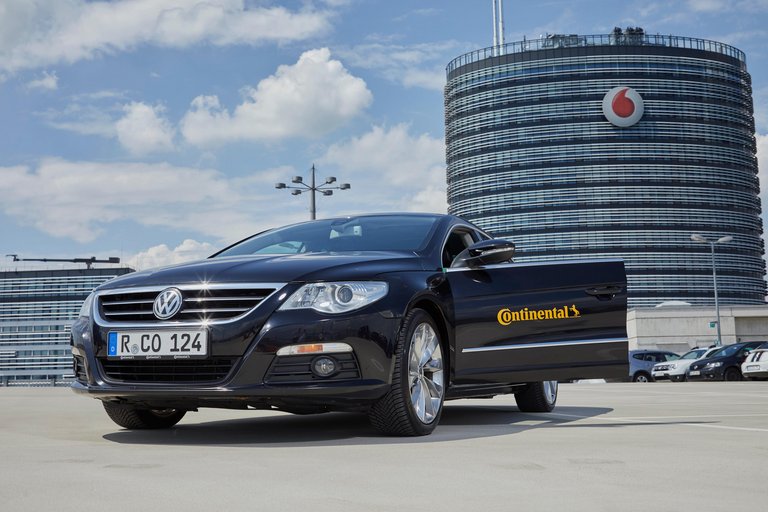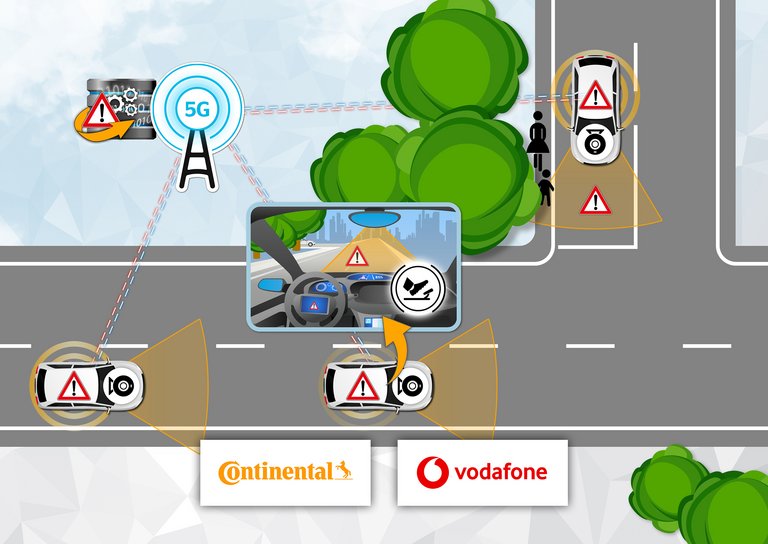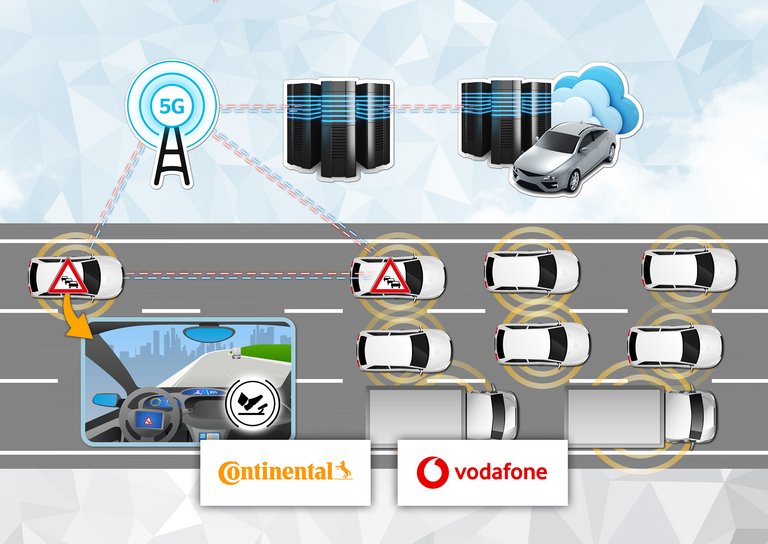Vodafone and Continental Are Using Connectivity to Make Germany’s Roads Safer
- Collaborative innovations to reduce traffic accident figures
- Digital shield protects pedestrians and cyclists on the roads
- Traffic jam warning system prevents rear-end collisions on the motorway
- Joint tests focus on 5G, V2X, mobile edge computing and artificial intelligence
Hannover, June 10, 2018. Vodafone and Continental have joined forces. The telecommunications group and the technology company are announcing a new innovation-driving partnership at CeBIT. Their objective is to improve the safety of German roads with smart vehicle connectivity and they will be collaboratively developing innovations to protect all road users. The two partners are already working on application scenarios at Vodafone’s 5G mobility lab. A digital shield for pedestrians and a traffic jam warning system are two of the focal projects. They will be implemented with 5G, cellular vehicle-to-everything (cellular V2X) and mobile edge computing.
7100 accidents happen on Germany’s roads every day
The traffic accident rate is at its highest level ever, with 7100 incidents occurring every single day on German roads. The consequences are shocking: around 1060 injuries and nine deaths every day according to the Federal Statistical Office. Vodafone and Continental are committed to reducing the accident rate with new connectivity technologies in a collaboration to improve road safety. The two partners are testing out new concepts that will benefit drivers, pedestrians and cyclists at the 5G Mobile Lab in Aldenhoven. “A mobile phone with a digital shield function can save lives on the roads," said Vodafone CEO Hannes Ametsreiter. “Collaborations spawn innovations, and innovations mean progress. Progress that will revolutionize our roads.”
Cellular V2X: direct communications between vehicles and the infrastructure
Johann Hiebl, Head of the Infotainment and Connectivity Business Unit at Continental, commented, “Continental has been working to connect vehicles to each other and to the infrastructure for more than 20 years. Today’s vehicles need superior automotive technology and superior connectivity technology. The cooperation with Vodafone brings experts from both worlds together to develop solutions with smart communication technologies such as 5G, cellular V2X and mobile edge computing that make our roads safer."
The partners are optimizing the wireless network to cope with the immense data requirements of the automotive industry at the 5G Mobility Lab. Tomorrow’s fully automated vehicles will generate up to one gigabyte of data every minute, some of which will be shared with other road users. 5G, the next generation of cellular network technology, will be capable of processing up to 10 gigabits of data per second and make it possible for millions of cars to communicate with each other simultaneously. Road users can only warn each other of potential hazards if they are able to share data in real time. Cellular V2X technology makes that possible because it connects the vehicle to the cloud and facilitates information sharing between vehicles or between vehicles and other road users. Continental and Vodafone are also testing mobile edge computing technology – a technology that enables cloud computing capabilities and an IT service environment at the edge of the cellular network. This technology significantly reduces both the volume of data to be transmitted and the transmission path, and puts information processing speeds into an entirely new dimension.
Cars communicating with pedestrians
Mobile edge computing technology will be used at the 5G Mobility Lab to test a digital shield for pedestrians and cyclists because around 25 percent of road traffic deaths (Federal Statistical Office) affect these two groups of road users. Vehicles will have built-in cameras to recognize pedestrians who suddenly decide to cross a road, for example. The camera will send live images to the mobile edge computer at the base station for lightning-speed Artificial Intelligence analysis.
If the system identifies a risk situation, it sends a warning to all the vehicles in the area via the wireless network. This also has advantages for car manufacturers, in addition to drivers and pedestrians. Relocating the computing power necessary for the risk analysis to the mobile edge computing server means that the manufacturer doesn’t have to integrate expensive chip sets in the car.
Cellular V2X technology can extend the radius of the digital shield by allowing vehicles, people and the infrastructure to directly share information, even when the hazard is beyond the reach of their own surround sensors. Every vehicle user profits from real time information from other vehicles. It allows the driver to make better, faster and more informed decisions in emergency situations, even if the hazard is outside the range of the vehicle’s own surround sensors. Pedestrian safety is also improved because drivers get advance warning if a pedestrian is dangerously close and are able to respond faster.
Traffic jam warning system to prevent rear-end collisions
The two partners are also developing a traffic jam warning system based on V2X technology. The vehicles in a traffic jam send data via cellular V2X directly to all the other road users in the vicinity – both via the conventional wireless network and direct communication technology. An alternative route can be proposed to vehicles that are still some kilometers away from the traffic jam so that they can circumvent it. Vehicles approaching the end of the traffic jam are sent a direct warning so they can reduce their speed and avoid the risk of a rear-end collision.

Sebastian Fillenberg
Head of Content, Media Spokesperson and Topic Manager Architecture and Networking
Continental Automotive



